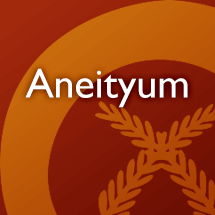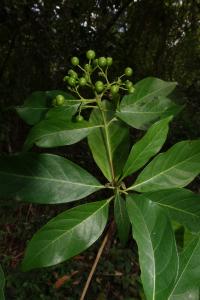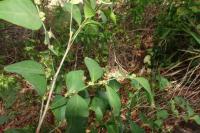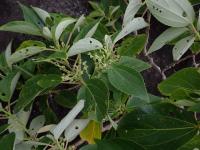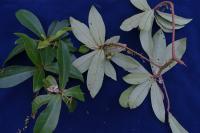Your search for * in fishing has returned 53 entries
inceimohos
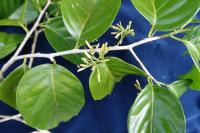
inmopoñ
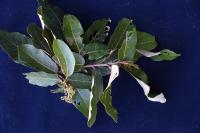
n. tree, 10 m tall (collection: Gregory M. Plunkett #3516)
Example: The young stems are used to make fishing spears. These stems are also used to make the poles that connect an outrigger to a traditional canoe, as they are light and strong. The large trees have extensive roots and stumps and are used as a pen for pigs by making a fence from these.
bookmarkinmoupog
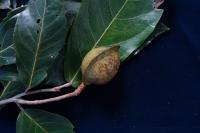
n. tree to 8 m, dbh 20 cm (collection: Michael J. Balick #4927)
Example: The wood of this tree is used as firewood. Children collect the dry fruits and use them for decorations and toys, for example playing with a fruit on the beach, driving it as if it were a toy truck or boat (photo).
bookmarkinpecelelcei paralelcei
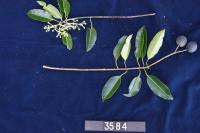
n. tree, 18-20 m tall (collection: Gregory M. Plunkett #3584)
Example: The young stems of this tree are very light, and used to make spears for fishing--they float. The stems are used to make the poles that connect the outrigger to the canoe. Good to make a fishing spear with as with others, timber. Leaves used with other plants to heal a sick woman who is sick from a male spirit – PARALELCEI – This lead with other leaves unspecified, tie together pound juice out of it and put juice in bamboo, cover top w/ wild cane leaf and take to sick woman before sunset, give to her to drink, before wave bamboo around her, open it and pour a bit on her head and drink a bit and wash her face, then break bamboo and discard it before sunset. Then tell spirit to go away. Symptoms such as a miscarriage or continued period, or dream and see the male spirit, or dream of snakes from the forest.
bookmarkinwou apeñ
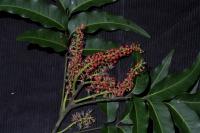
muri muri
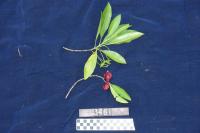
muri muri
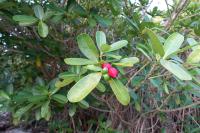
murimuri
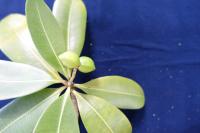
naero
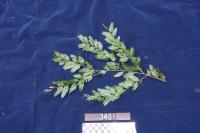
n. sapling directly under large tree of same species (20-25 m tall), growing in primary forest. Sterile. (collection: Gregory M. Plunkett #3451)
Example: 1. Wood used for timber boards. 2. Timber tree, sawn timber young stems for spear fishing, clean bark, heat it, affix tips on the end.
bookmarknahein
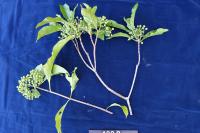
n. shrub to 1 m tall, frits green. Red clay soil (collection: Michael J. Balick #4880)
Example: Stems are used to produce cyclone houses--secure wild cane (Miscanthus) on the roof of the house. Fold cane in half over the stem of this plant and then lay it on the roof. Makes layers that resist the wind. The stem of this plant can be sharpened to make a fishing spear, or used as the shaft and a few wires are attached to the end.
bookmarknaheñ
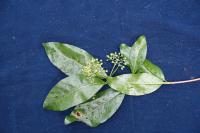
naheñ
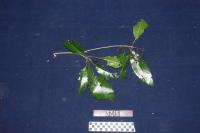
naheñ
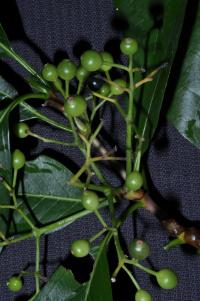
n. tree, 4 m tall (collection: Gregory M. Plunkett #4066)
Example: 1. Young saplings are used to prepare a fishing spear. First a straight sapling is chosen and sized. Then it is heated over a fire to render it pliable. After the length is straightened, it is decorticated. Once cooled, a portion of wire can be affixed to an end to aid in spearing fish.
bookmarknahoj
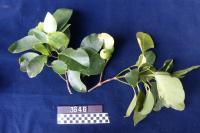
n. tree, 7 m tall (collection: Gregory M. Plunkett #3646)
Example: The ripe fruits of this species smell very nice and people eat the inside part, which tastes similar to a banana. When fruit is ripe the outside is yellow and the inside is purple. The wood can be used for poles to make house rafters. When kids go fishing for shrimps they use the fruit to catch the shrimp by throwing the shrimp into the water which attracts the shrimp.
bookmarknahoj
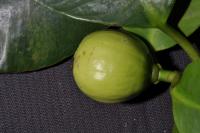
nahojcei
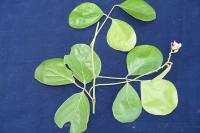
n. low-growing vine, growing next to airstrip just beyond coastal vegetation. Flowers purple. (collection: Gregory M. Plunkett #3544)
Example: To trap fish, the vine of this plant is rolled in large quantity and put on the reef in a circle at high tide in order to corral and trap the fish. At low tide the fish are then speared and harvested. Placement of the circle depends on the rocks and the reef. Children fold the large leaves and bite parts of the leaf to make designs as a craft object. This is a "message plant." If a person wants to build a house or garden in a specfic place, put a piece of the vine on a stick near the area to tell others that they should not build a garden or house hear this area--this is a Tabu message. There are a few other unspecified leaves added to the stick, not only this one.
bookmarknahojcei
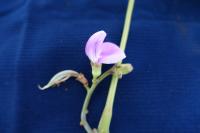
nairo
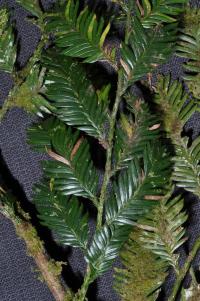
n. sapling, 3 m tall (collection: Gregory M. Plunkett #4106)
Example: 1. Sapling wood is used to make fishing spears. A straight sapling is first heated in the fire to render it pliable. The sapling is further straightened and then decorticated. Once cooled, wire can be added a prong to the end of the spear.
bookmarkname
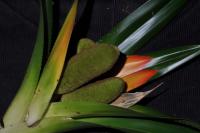
n. epiphytic liana, growing in primary forest. Bracts orange-red at base. (collection: Gregory M. Plunkett #4029)
Example: 1. The roots of this plant are used to make "Nopoy"--a traditional trap used to catch fish and lobster. The outer bark of the roots are removed and sun-dried. The roots are then split into several pieces and they are woven in an open fashion similar to a "noporapora"--a type of market basket fashioned from coconut leaflets.
bookmarkname cedo
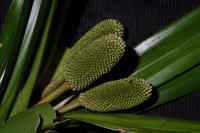
n. epiphytic liana climbing up several canopy trees, growing on slope in primary forest. (collection: Gregory M. Plunkett #4023)
Example: 1. The roots of this plant are used to make "Nopoy"--a traditional trap used to catch fish and lobster. The outer bark of the roots are removed and sun-dried. The roots are then split into several pieces and they are woven in an open fashion similar to a "noporapora"--a type of market basket fashioned from coconut leaflets.
bookmarkname cedo
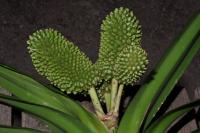
natji
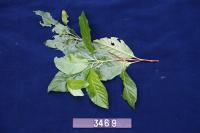
naupitcat
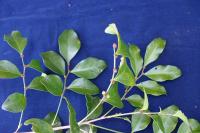
nedwodou
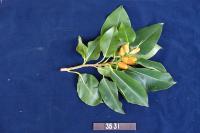
n. tree, 10 m tall (collection: Gregory M. Plunkett #3531)
Example: 1. For a child around 1 year of age, take the inside bark, mash it, boil in hot warter and then use it to wash the child. This will ensure that the child will grow strong and make them able to crawl fast. 2. If a woman who is one month pregnant would like to have a baby, she is given 4 of the tips of the branches to chew and swallow everything before breakfast 1x only. 3. For fishing, take 4 leaves, hold top side up, tear right half of leaves off, keep left side, roll it up and put with fishing gear to have good luck when fishing in the deep sea beyond the reef.
bookmarknedwodou
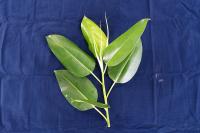
n. tree to 6 m, dbh 10 cm (collection: Michael J. Balick #4865)
Example: To bring luck when fishing. Take 4 leaves with stems still on them-- first thing in the morning, when it is cool and quiet and there is not much noise, break the left hand side from two leaves and the right hand side from two leaves (total 4 half leaves) and take those pieces and put in the bag containing your fishing gear. The meaning of the local name is that "these leaves will please the Sea God" who will not understand it if a fisherman does not have leaves with them on their trip. There are groups of people who are part of the Sea Gods and you must notify these people before you go out to fish. If you have these leaves in your bag, you are said to get many fish. In the past certain people were responsible for the harvest from the sea; these people used to know this ritual. Not much known at present. Birds eat the fruit of this tree as does the flying fox.
bookmarknejeg
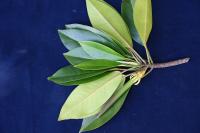
n. tree, 8 m tall (collection: Gregory M. Plunkett #3514)
Example: 1. The wood is strong and good to make house posts. People use these for this purpose on the coast as salt water does not bother this wood. 2. People eat fruit, split fruit in half, carefully scrape the inner part into a pot of water, keep over night – next day rinse, fry or cook with coconut milk and can add tinned tuna for example, very hard work.
bookmarknejeg
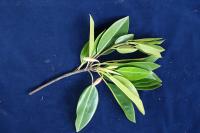
n. tree, growing in forest at edge of wide tidal stream (collection: Gregory M. Plunkett #3535)
Example: 1. The wood is strong and good to make house posts. People use these for this purpose on the coast as salt water does not bother this wood. 2. People eat fruit, split fruit in half, carefully scrape the inner part into a pot of water, keep over night – next day rinse, fry or cook with coconut milk and can add tinned tuna for example, very hard work.
bookmarknejeg
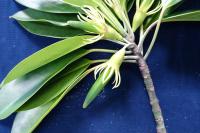
n. tree to 4 m, dbh 8 cm (collection: Michael J. Balick #4925)
Example: The wood of this tree is hard and used for house posts. It grows in the water or inundated areas, fish, crabs, sea creatures use the roots of this tree to hide and breed. People know that this tree stops big waves and therefore protect the trees.
bookmarknejeg tau
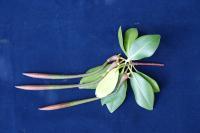
nelm̃ae
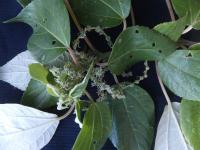
n. small tree. Found in the village, but not cultivated. (collection: Ashley A McGuigan #17)
Example: 1. Ancestors used this plant to make fish line – cut young branches, remove outer bark and tie together, put in salt water or fresh water for a week, it is now strong, dry in sun, take fibers and twist them together to make a very long fishing line. 2. Leaves are used to feed pigs. 3. Take inner bark, scrape it and put on boils. Attach with any leaf and it takes out the boil. 4. Trunk for temporary bush house.
bookmarknelmai
n. a tree from the inner rind of which fishing lines and nets are made. na elmai or elumai, cloth
bookmarknelm̃ai
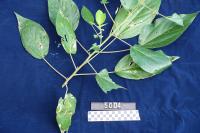
n. tree to 4 m tall, dbh 8 cm (collection: Michael J. Balick #5004)
Example: This plant is used to make fishing line, perhaps moreso in the past than today. Collect young shoots form the sides of the tree, peel off the bark, soak the stem in salt water or fresh water for 1-2 weeks to ret the stems then separate the fibers, dry in the sun and use to make string for fishing. The leaves are used for feeding pigs.
bookmarknelm̃ai
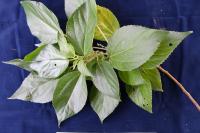
n. tree to 8 m, dbh 10 cm (collection: Michael J. Balick #4863)
Example: Fiber: Collect the stems of this plant, peel off the outer bark, soak (ret) in seawater for 1 week, then put stone on top of it-the fibers are loosened by the retting, peel them off and hang in the sun to dry and bleach. Weave small baskets, grass skirts and other things from this fiber. When sticks are placed in areas of the sea, shells are attracted to these sticks and people can collect the shells used for adornment--the animals in the shells like to eat the material on the sticks. Dried fruits of this plant are eaten by birds.
bookmarknelm̃ai apeñ
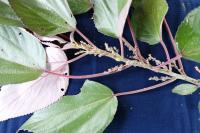
n. tree 6 m tall, dbh 15 cm (collection: Michael J. Balick #4864)
Example: Fiber: Collect the stems of this plant, peel off the outer bark, soak (ret) in seawater for 1 week, then put stone on top of it-the fibers are loosened by the retting, peel them off and hang in the sun to dry and bleach. Weave small baskets, grass skirts and other things from this fiber. When sticks are placed in areas of the sea, shells are attracted to these sticks and people can collect the shells used for adornment--the animals in the shells like to eat the material on the sticks. Dried fruits of this plant are eaten by birds.
bookmarknemered
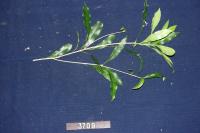
nese
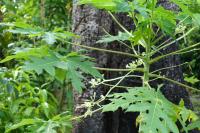
n. shrub to 2 m, flowers white. forest near house. (collection: Michael J. Balick #4871)
Example: A handful of flower buds are collected and put into water with 1-2 pieces of papaya roots. Heat the water and drink it hot for the treatment of hypertension or vein problems, or to promote circulation in overweight people. Do this treatment 1x a month. The white sap is collected and used to soften octopus flesh for eating. Put sap, fruits and chopped leaves in a bowl and add the octopus, allowing it to remain in the bowl for 1 hour--this will soften the flesh of the animal. The sap can be used to wash the skin of tough beef or wild pig--it helps to "burn" off (remove) the skin. When cooking tough meat, take young fruits of this tree and cut them up and put them in the pot with the meat, boil it to soften the meat which can then be cooked.
bookmarknetemu
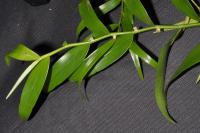
nijom̃kan
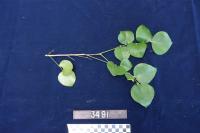
n. shrub, 1 m tall (collection: Gregory M. Plunkett #3491)
Example: Name means smash tooth. 1. This is part of an unspecified mixture that can be used as a spell to give another person a toothache. 2. Toothache – chew leaves on the sore tooth and leave it there for a while and spit it out – it will break the tooth and you can take it out, leave on 20 minutes.
bookmarknisyeg
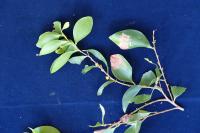
n. tree, 6 m tall (collection: Gregory M. Plunkett #3574)
Example: 1. The inner bark of this plant is used as a dye or paint to provide a brown color. Boil the inner bark in a pot with a shirt and the color of the shirt will be changed to brown. 2. For toothache, people take the inner bark and mix it with sea water, and then rinse the tooth with this mixture to remove the pain. 3a. People macerate the leaves and the bark and when the tide is low, spread this in a pool of water to poison the sea shells that are edible. When they die, the eyes of this organism comes above the sand, indicating where they are, and people harvest and eat them. 3b. To attract and collect clam – NIPJINUMU – scrape bark in a pool of sea water where the clams are attracted immediately and can be collected, coming up from the sand. 4. Firewood, unspecified medical use.
bookmarknisyeg
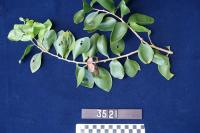
n. tree, 7 m tall (collection: Gregory M. Plunkett #3521)
Example: 1. The inner bark of this plant is used as a dye or paint to provide a brown color. Boil the inner bark in a pot with a shirt and the color of the shirt will be changed to brown. 2. For toothache, people take the inner bark and mix it with sea water, and then rinse the tooth with this mixture to remove the pain. 3a. People macerate the leaves and the bark and when the tide is low, spread this in a pool of water to poison the sea shells that are edible. When they die, the eyes of this organism comes above the sand, indicating where they are, and people harvest and eat them. 3b. To attract and collect clam – NIPJINUMU – scrape bark in a pool of sea water where the clams are attracted immediately and can be collected, coming up from the sand. 4. Firewood, unspecified medical use.
bookmarknop̃ou
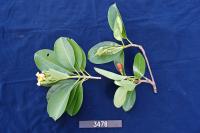
n. large epiphyte on dead tree, growing in open forest. (collection: Gregory M. Plunkett #3478)
Example: The wood of this plant is very hard and can be used for house posts. Because the wood is somewhat heavy, younger stems can be sharpened at one end and the pole can be used to plant dryland taro, to make holes for the tubers. For planting swamp taro, the leaves can be used to line the pit that the taro is planted in; it is a local fertilizer for the taro, and as it rots the soil becomes soft while the taro is growing. The flowers are placed behind one’s ear to enjoy the fragrance or can also be used to make a floral necklace (Intañ).
bookmarknopou
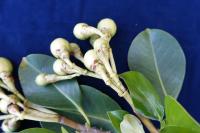
n. tree to 5 m, dbh 10 cm (collection: Michael J. Balick #4881)
Example: The wood of this tree is used to make house-posts, it is strong. The leaves are used as a compost for the taro patch; line the hole with the leaves of this tree, then place soil over that and plant the taro. When the fruits are ripe, local people say that the hermit crabs are "fat" and ready to collect and eat. When a person is in the forest and there is no coconut fruit fiber to start a fire with, use a dry stick, shave it and use a match to start a pile of this tinder to make a good fire. The wood is said to be "oily." This gives it a nice aroma. To perfume coconut oil, drop the dry flowers in it--use 1 handful of dried flowers added to a pot of oil boiling on the fire while making it. Strain out flowers and the oil smells good. Flowers can also be added to the oil once it is bottled to perfume it.
bookmarknop̃ou
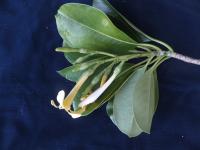
n. tree. Found in the village, usually grows in the hills. (collection: Ashley A McGuigan #16)
Example: 1. Lot of oil in the heartwood so it is good to start a fire, split it into small strips and you can light it for a fire. 2. Calendar plant – when the fruits ripen people know that this is the best season to eat the big hermit crab – meaning that they are fat.
bookmarknudto
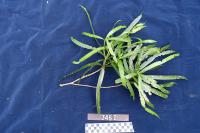
n. small tree, 4 m tall (collection: Gregory M. Plunkett #3452)
Example: 1a. The stem of this plant is used to make a spear, as it is always straight and very strong. It is a small growing plant, just right for length of a spear. 1b. Make a spear for fishing, peel bark, heat stem, affix points to end. 2. Name is the name of a fish. 3. Rafters for roof.
bookmarknuhujcei
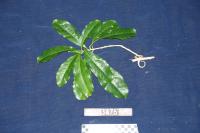
n. liana, growing at edge of forest. Fruit. (collection: Gregory M. Plunkett #3475)
Example: 1. When the stems of this plant are older, and it is a vine, is used to tie thatch on roof rafters as it bends well. 2. Burned leaves and rubbed on fishing line and spear to increase catch – used with other unspecified leaves, that are forageable. When you are fishing and if you set a basket or mat it means danger and you have to return to shore – the spirit is telling you that it is enough fishing.
bookmarknuhujcei
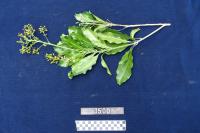
n. liana, climbing on fallen tree (collection: Gregory M. Plunkett #3500)
Example: 1. When the stems of this plant are older, and it is a vine, is used to tie thatch on roof rafters as it bends well. 2. Burned leaves and rubbed on fishing line and spear to increase catch – used with other unspecified leaves, that are forageable. When you are fishing and if you set a basket or mat it means danger and you have to return to shore – the spirit is telling you that it is enough fishing.
bookmarknuhujcei
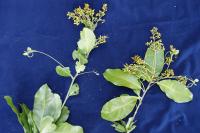
n. liana, climbing on Garcinia tree (collection: Gregory M. Plunkett #3585)
Example: 1. When the stems of this plant are older, and it is a vine, is used to tie thatch on roof rafters as it bends well. 2. Burned leaves and rubbed on fishing line and spear to increase catch – used with other unspecified leaves, that are forageable. When you are fishing and if you set a basket or mat it means danger and you have to return to shore – the spirit is telling you that it is enough fishing.
bookmarknuhujcei
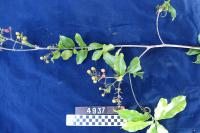
n. vine to 5 m, flower yellow (collection: Michael J. Balick #4937)
Example: In the old days, the hooks of this plant were used as a kind of small fishing hook. Heat the hook over a fire to make it strong, tie a rope to it and use it to catch fish. Take inner bark--1 handful and boil in a full pot of water and wash the body 1x daily to treat scabies. Can work in as soon as 2 days. It cures the sores very fast.
bookmarknunyepec
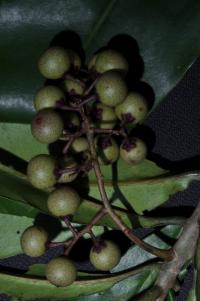
n. understory tree, 6 m tall (collection: Gregory M. Plunkett #4049)
Example: 1. The name means "knife of sandpaper", a type of fish. The leaf base resembles the fin of the fish. 2. In the past, a spear was made from the sapling wood of this plant for tribal warfare. Today, spears are made from this plant for fishing. First, a relatively straight spaling is chosen and then heated over a fire. The pliable portion of wood is straightened and then decorticated. When cool, a portion of wire can be affixed on one end to aid in the spearing of fish.
bookmark